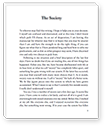Essay Instructions: In Du Bois' book "The Souls of Black Folk," he prefaces ?Of the Black Belt? with the spiritual, ?Bright Sparkles in the Churchyard.? Here is the text of this sorrow song; I have italicized the words that correspond to the bars of music reproduced by Du Bois?s epigraph:
May the Lord, He will be glad of me,
May the Lord, He will be glad of me,
May the Lord, He will be glad of me,
In the heaven He?ll rejoice. . .
Bright spar-kles in the churchyard
Give light un-to the tomb,
Bright summer, Spring?s o-ver,
Sweet flow-ers in their bloom,
Bright spar-kles in the churchyard
Give light un-to the tomb. . .
Mother, rock me in the cra-dle all day. . .
Mother, rock me in the cra-dle all day. . .
All the day, all the day,
Oh, rock me in the cradle all the day. . .
Oh, mother, don?t you love your darling child,
Oh, rock me in the cra-dle all the day.
Mother, rock me in the cra-dle,
Mother, rock me in the cra-dle,
Mother, rock me in the cra-dle all the day. . .
This text speaks of resurrection through entrance into heaven, through being raised from the dead, and through the comfort of a mother who could be understood variously (as the church, as the slave mother, as a figure for the African homeland). The title, ?Bright Sparkles,? also alludes to the surviving African practice of decorating graves with broken glass, china, shells, pottery, etc. These decorations function in different ways: to signify the breaking of the chain of life, to keep the dead from returning, or to prevent evil spirits from harming the dead. Grave decorations are therefore an element of African-American funeral practices that, especially in the nineteenth-century South, indicate the survival of strong African beliefs, beliefs in the continued presence and communion with generations of ancestors. As such, they may be said to constitute, as John Vlach argues, a ?visual environment which in the Afro-American tradition is seen as the world of the spirits, often the spirits of the ancestors. Graveyard goods,? Vlach continues, ?are a statement of homage; their function is to keep a tempestuous soul at rest? (The Afro-American Tradition in Decorative Arts 139). More particularly, bits of broken glass, mirrors, or other reflective or sparkling objects have a spiritual function, representing what Robert Farris Thompson calls the ?flash of the spirit,? the glint or spark of the soul that is released in death on its journey to the home world of the ancestors (?African Influence,? Afro-American Folk Art and Crafts 47-50; also see Flash of the Spirit 118-42).
In this essay, I should first like for you to discuss the relations between Du Bois?s epigraph in "The Souls of Black Folk" and the chapter?s argument, from the chapter "Of the Black Belt" about ?the Egypt of the Confederacy.? How do the sorrow songs (which Du Bois comments on in his last chapter "The Sorrow Songs" comment upon the ?work and striving? of African-Americans in the rural South and throughout the African diaspora? (Please use the epigraph and these two chapters from "The Souls of Black Folk"). What is that commentary?s relation both to the labors and to the cultures of the enslaved, then the imperfectly freed peoples of the ?Black Belt??
Then, using two other texts (text options provided below) extend your discussion into a larger consideration of the relations between the past of slavery and the continuing emergency of the postbellum years (the present moment of a ?second slavery,? as Twain describes it). How do the secret and the stolen ?gifts? of African-America?the gifts, writes Du Bois, of ?story and song,? of ?sweat and brawn,? and of ?Spirit? (described in his last chapter of "From the Souls of Black Folk", titled "Sorrow Songs")?provide the materials for the cultural work, not only of resistance to inhumanity, but of imagining and indeed recreating new forms of specifically African-American collective life? (Insofar as ?America? in any normative sense would not have been, and cannot be, ?America without her Negro people,? you may develop this point in the universalizing direction of another, greater social world, one worthy of humans.) In other words, how do the writers of the period that Charles Chesnutt has described as ?Post-Bellum?Pre-Harlem? work to imagine the cultural forms of what already exists, though only in the many fragments of sound and silence beyond the extant texts?the forms of a damaged yet enduring heritage? What is the relation of this inheritance to the social forms of African-American life after Emancipation, to community?
Please use two of any these texts (which ever can be applied best to essay):
Fredrick Douglass, "Narrative of the Life of Fredrick Douglass"
Harriet Jacobs, "Incidents in the Life of a Slave Girl"
Harriet Wilson, "Our Nig"
Frances Harper, "Iola Leroy"
Charles Chesnutt, "The Marrow of Tradition"
James Weldon Johnson, "Autobiography of an Ex-Colored Man"


